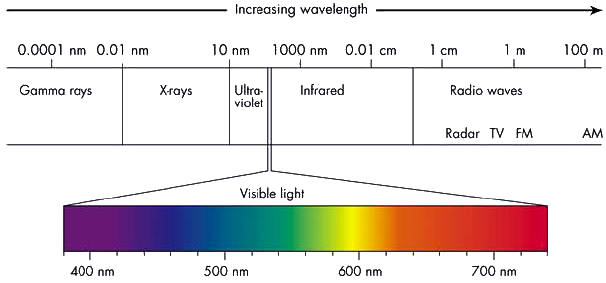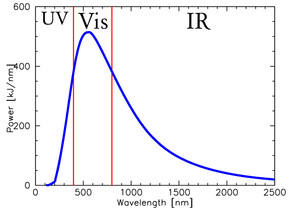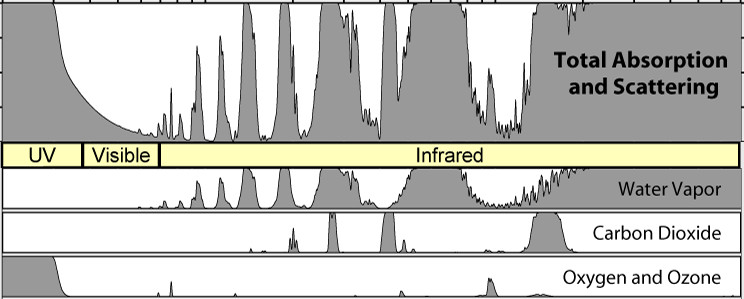The light that ours eyes are sensitive to is but a very small part of the light that permeates our universe. The entire range of light is referred to as the electromagnetic spectrum. The diagram below show the range of the electromagnetic spectrum.
In this class we are going to characterize light by its wavelength. In the diagram below, the electromagnetic spectrum is arranged so that light with short wavelengths are to the left, and long wavelengths to the right.
As you can see, the part of the spectrum we can see is call visible light. We have all seem that when while light passes through a prism, it is separated into the various colors that make up the visible part of the spectrum. Each of these colors correspond to a specific wavelength of light. In this class we measure the wavelength of light in nanometers (nm). One nm is equal to one billionth of a meter. The human eye is sensitive to light in the range of 380 to 750 nm.

Our eyes can not see light that falls outside the visible part of the spectrum. However, we can make instruments that can detect and measure this radiation. This is very useful, since a lot happens in our solar system outside of the visible part of the spectrum.

The plot on the right shows all of the light that is produced by our Sun. The blue line is called the solar spectra. As you can see, the highest point of the solar spectra is in the visible part of the spectrum. In fact the peak occurs at a wavelength of about 600 nm, which corresponds to the yellowish part of the visible spectrum. This is the reason the Sun looks yellowish in the sky.
However, you can see that the Sun also produces a lot of light that falls outside the visible part of the spectrum. As a matter of fact, 49% of the Sun's energy comes out in the infrared part of the spectrum. A little (about 5%) comes out in the ultraviolet part of the spectrum, leaving about 46% of the energy pouring out in the visible part.
What this means is that there is a lot of infrared and visible light coursing through our solar system, interacting with all of the worlds. It is this type of light we will be talking about mostly in this class.
While all the worlds interact with the same spectra of light from the Sun, each world interacts with it differently. Far example, while the entire range of radiation from the Sun hits the top of the Earth's atmosphere, not all of that radiation makes it to the surface. The characteristic of an atmosphere that describes which wavelengths of light get thought and which are block, is called the atmospheric transparency.
The atmospheric transparency of the Earth's atmosphere is shown in the plots below. As you can see, the Earth's atmosphere let in most of the visible part of the spectra (no surprise). We say that the Earth's atmosphere is transparent in the visible. However, the atmosphere blocks most of the ultraviolet and infrared parts of the spectrum. The Earth's atmosphere is opaque in the ultraviolet and infrared.
One practical aspect of this is that telescopes that are sensitive in the ultraviolet are useless on the surface of the Earth. The sky would appear blank. Ultraviolet telescopes are only useful above the Earth's atmosphere. There is a similar story in the infrared. However, as you can see, there are a few ranges of wavelengths in the infrared part of the spectrum that do make it to the ground. These so-called infrared windows are used all of the time by astronomers. Getting above most of the atmosphere by going to mountain tops, help a lot to.

The plots on the bottom part, show what in our atmosphere is responsible for blocking the ultraviolet and infrared light (the grey areas represent part of the spectrum blocked by the gas). The ultraviolet is mostly blocked by our ozone layer, while the infrared is block mostly by water vapor and carbon dioxide. Both of these features are very important to life on the surface of the Earth, and we will be hearing about it a lot in class.